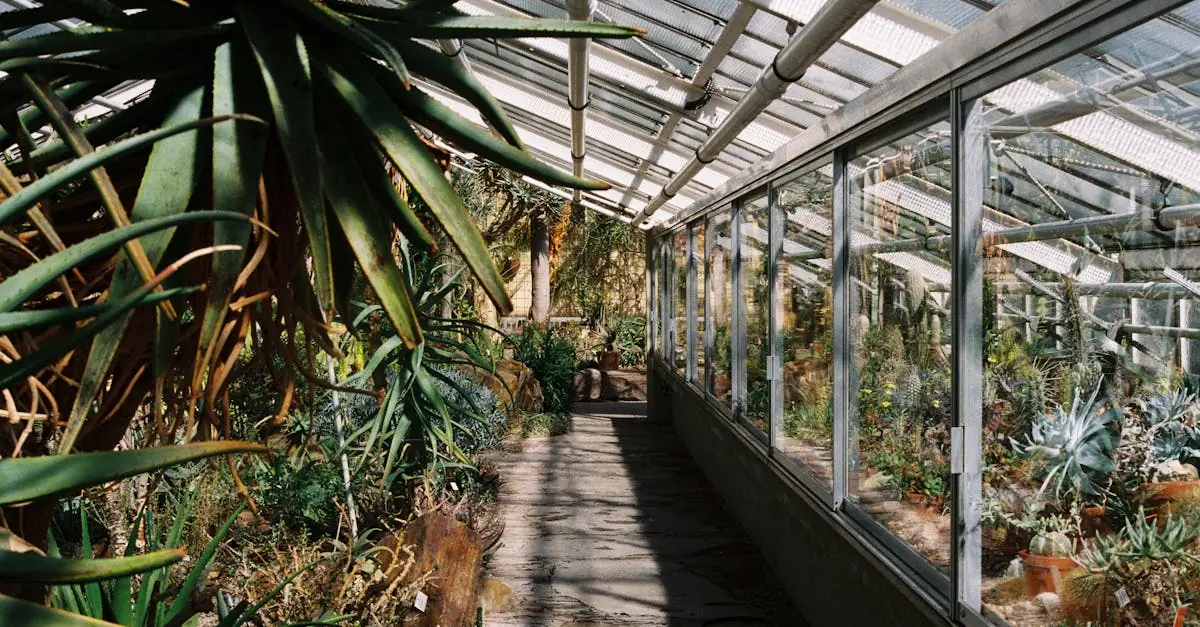Indoor gardening isn’t just for green thumbs or those with a PhD in botany. It’s for anyone who wants to turn their living space into a lush oasis, even if they can barely keep a cactus alive. Imagine the joy of snipping fresh herbs for dinner or the satisfaction of nurturing a plant from a tiny seedling into a thriving beauty.
Table of Contents
ToggleUnderstanding Indoor Gardening
Indoor gardening offers a rewarding experience for individuals seeking to cultivate plants in their homes. This practice promotes creativity and relaxation while enhancing indoor spaces.
Benefits of Indoor Gardening
Growing plants indoors provides several benefits. Fresh herbs and vegetables improve the taste of meals while contributing to healthier eating. Indoor plants enhance air quality, filtering toxins and increasing humidity, which promotes well-being. Additionally, indoor gardening reduces stress, offering a calming hobby for busy lifestyles. Aesthetic appeal plays a vital role as well, with greenery adding beauty and life to any room. These advantages encourage more people to explore indoor gardening.
Common Challenges Faced by Beginners
Beginners often encounter specific challenges when starting indoor gardening. Limited natural light affects plant growth, requiring the careful selection of plants that thrive in low-light conditions. Overwatering remains a frequent issue, leading to root rot and plant decline. Beginners sometimes struggle with pest management, as indoor environments can attract common household pests like spider mites and aphids. Selecting the right soil also presents difficulties, with various options available that suit different plant types. Recognizing these challenges enables individuals to develop strategies for successful indoor gardening.
Getting Started with Indoor Gardening
Indoor gardening starts with understanding the basics. Selecting the right space for your plants and gathering essential tools simplifies the process and increases success.
Choosing the Right Space
Identify an area that receives adequate light. Windowsills or bright corners work well for most plants, allowing them to thrive. Ensure the location maintains a stable temperature, ideally between 65°F to 75°F. Avoid spots with drafts or extreme temperatures, as they can stress your plants. Evaluate the available moisture levels in the space too. Excess moisture or dryness can hinder growth, so choose a suitable environment for your chosen plants.
Essential Tools and Supplies
Gathering necessary tools enhances the indoor gardening experience. Start with pots or containers that feature drainage holes, allowing excess water to escape. A good quality potting mix supports healthy root development. Use fertilizer tailored to the specific needs of the plants, ensuring they receive vital nutrients. Include tools like a watering can, hand trowel, and pruning scissors in your collection. These items aid in maintaining and caring for your plants efficiently.
Selecting Plants for Beginners
Choosing the right plants is crucial for success in indoor gardening. Beginners should consider plants that thrive in low-light conditions and require minimal care.
Best Indoor Plants for New Gardeners
Some excellent choices include pothos, peace lilies, and snake plants. Pothos boasts adaptability and tolerates neglect, making it perfect for beginners. Peace lilies offer beautiful blooms and improve indoor air quality. Snake plants withstand varying light levels while requiring infrequent watering. Other suitable options consist of spider plants and ZZ plants, known for their resilience and easy maintenance.
Factors to Consider When Choosing Plants
Light availability should guide plant selection. Certain plants prefer bright indirect light while others thrive in low-light conditions. Understanding water requirements is essential; some plants enjoy a moist environment while others prefer dry soil. Temperature preferences also impact plant health, with some species thriving in warmer homes while others appreciate cooler spaces. Evaluating the humidity levels in indoor spaces can further influence plant choices, as tropical plants typically thrive in higher humidity.
Setting Up Your Indoor Garden
Creating an indoor garden involves careful planning and consideration. Beginners should prioritize soil quality and lighting to ensure plant health.
Soil and Planting Techniques
Quality soil fosters healthy growth. Use a well-draining potting mix that retains moisture while preventing root rot. Consider opting for a mix designed specifically for indoor plants, which typically includes peat, perlite, and vermiculite. When planting, ensure each pot has drainage holes to allow excess water to escape. Place plants at the same soil level they were in their nursery pots. Watering should be consistent, avoiding both dryness and waterlogging for optimal results.
Lighting Conditions and Options
Lighting plays a crucial role in indoor gardening success. Assess the available light in the chosen area to determine suitable plants. For low-light locations, consider using grow lights to supplement natural light. LED grow lights are energy-efficient and provide the spectrum plants need for photosynthesis. Set the grow lights about 12-24 inches above the plants and use them for 12-16 hours a day. As plants grow, adjust the light intensity and distance to ensure they thrive.
Maintaining Your Indoor Garden
Maintaining an indoor garden requires attention to detail and consistency in care practices. Two key aspects of this maintenance involve watering and fertilizing, along with effective pest control and disease management.
Watering and Fertilizing
Watering involves a careful balance. Plants require moisture but can suffer from overwatering. Checking the top inch of soil ensures the right timing for watering. Fertilizing delivers essential nutrients. Using a balanced, water-soluble fertilizer every four to six weeks promotes healthy growth. Observing plant response to watering and fertilizing helps adjust the schedule. Signs of underwatering include drooping leaves, while yellowing leaves may indicate overwatering. Tailoring these practices ensures flourishing plants.
Pest Control and Disease Management
Pest control is essential for maintaining a healthy indoor garden. Regular inspection of plants allows early detection of issues. Common pests include spider mites, aphids, and mealybugs. Treating infestations with insecticidal soap or neem oil serves as an effective solution. Disease management also requires vigilance. Fungal infections can stem from high humidity or poor air circulation. Maintaining proper spacing between plants promotes airflow. Implementing these strategies ensures the longevity and vitality of the indoor garden.
Indoor gardening is a fulfilling and enriching hobby that anyone can embrace. By understanding the basics and selecting the right plants and tools, beginners can create a thriving indoor oasis. The benefits extend beyond just aesthetics; they include improved air quality and the joy of harvesting fresh produce right from home.
With a bit of patience and care, challenges like limited light and pest management can be overcome. As they nurture their plants, individuals will find a sense of achievement and relaxation that enhances their living spaces. Starting this journey not only cultivates greenery but also fosters a deeper connection with nature.




